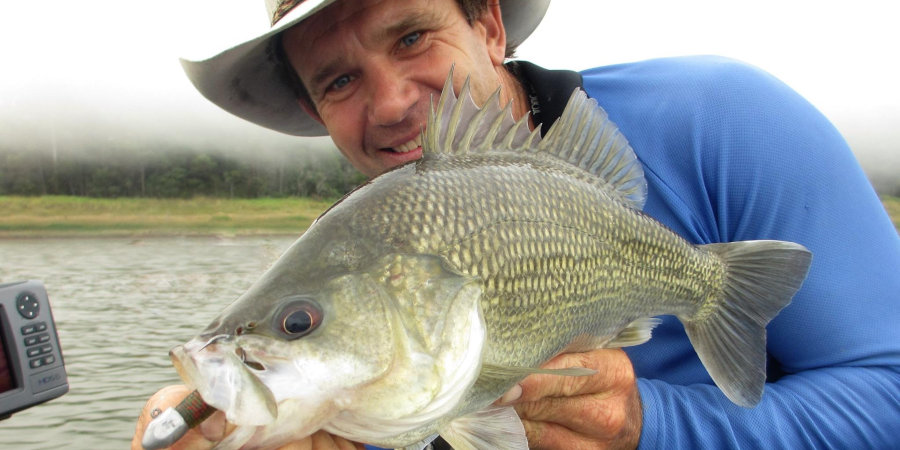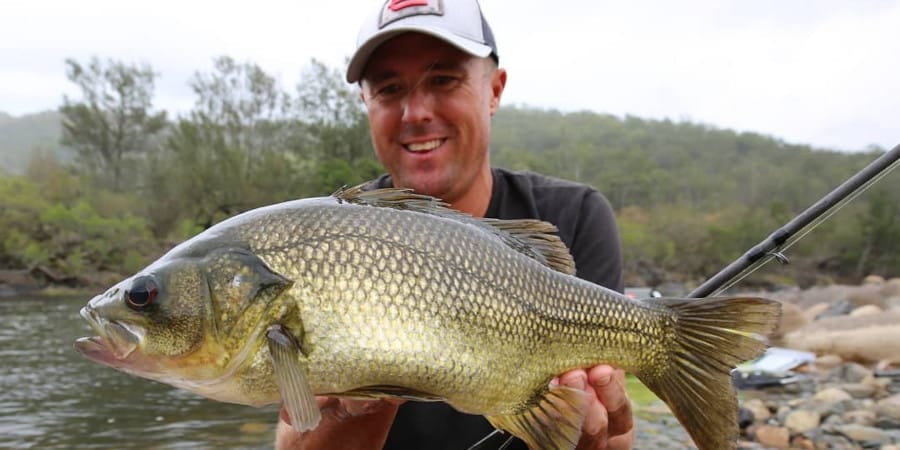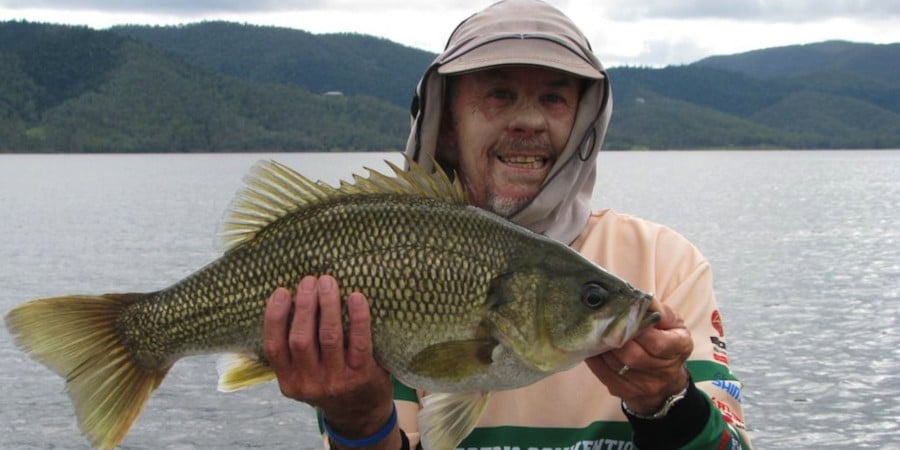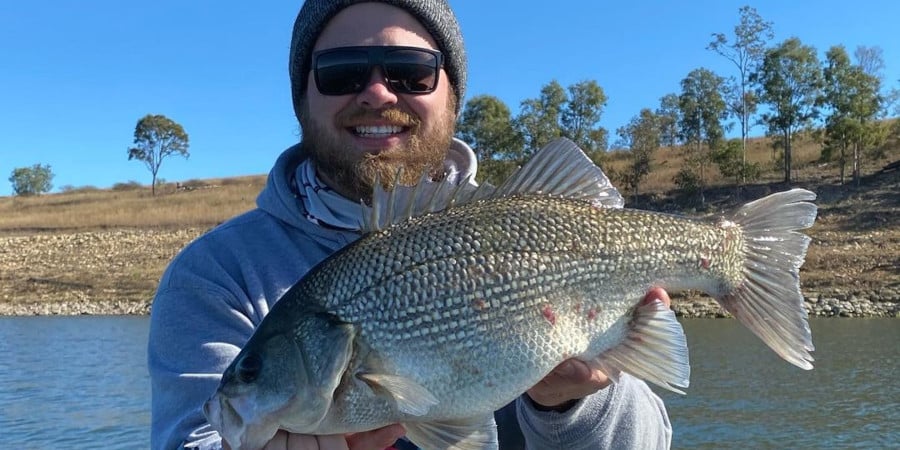
Charles’ Maroon Dam Bass Fishing Tips
- Maroon Dam is a storage where the lures and techniques used for bass fishing can vary widely. For this reason, Charles uses this system as a testing ground for techniques.
- Although there are plenty of fish in the far corners of the dam, it’s not necessary to travel long distances to find fish in this system. Some of Charles best sessions have occurred when he’s fished within spitting distance of the boat ramp. There are plenty of shore-based options as well.
- Australian bass can be taken on surface lures in the shallow water around the shoreline all year round, but the low light periods around dawn and dusk fish best. During the warmer months fish tend to move to the weedbed margins in 15-20 ft of water through the rest of the day.
- Getting weed on your hook is a good sign that you’re fishing in the right area, as that’s where bass tend to hang in Lake Maroon.
- Fishing areas where there is mixed structure such as gravelly rock transitioning into broken weed is a great area to fish if you’re shore based.
- When you’re fishing weed, concentrate on the fringes and look for little indents, broken patches, channels and valleys through the weed that hold bass. Often bass bit aggressively in the weed because you’re getting a reaction bite.
- Generally only the smaller fish seem to school in Maroon Dam, larger fish tend to be more solitary and hang close to their favourite structure.
- Once you’ve found fish, put in a half dozen casts with each of your favourite lure styles and if you’re not catching fish, mark the patch and move on, then come back later. Bass often start feeding at different times of the day.
- Charles finds that once he cracks the code and finds what’s working at a particular spot, that lure and technique will usually also work at other spots. However, he continues to rotate through lures, even after he catches some fish, to see what could be working better on the larger fish.
- “Matching the Hatch” is key to Aussie bass fishing. Find lures that resemble what the bass are feeding on in terms of size, profile and colour.
- “Perfect” conditions for Australian bass fishing on Maroon Dam would be temperatures not above 27-28 C, moon rising close to sun rise, glassy calm around dawn but a slight breeze later. A barometer above 2015 and rising is often good for fishing and overcast conditions, even with some drizzling rain, are great.
- If the fish are shut down, Charles suggests slowing thing down and working lures subtly.
- If (when) a hooked fish buries you in weed it’s best to position your boat or kayak above the fish and exert constant, moderate upwards pressure. Often the fish will thrash itself free when you do this, when pulling it from an angle will only cause it to burrow deeper into the weed.
Charles’ Maroon Dam Australia Bass Tackle
- Spin gear consisting of a suitable rod, 1000-2000 size reel loaded with 6-12lb braid and a 6-12lb leader is great for throwing lighter lures.
- A baitcast rod with 12-25lb line is great for throwing heavier lures with a 10-20lb fluorocarbon leader. 25lb may seem excessive, but Charles finds it necessary when throwing lures into tough, rocky cover as fish have to be stopped immediately to prevent bustoffs.
- For specific applications Charles will use straight through 10-12 lb mono or fluorocarbon on baitcast gear.
Charles’ Maroon Dam Bass Fishing Lures
- First thing in the morning or late in the afternoon when the wind is calm, topwater lures such as poppers, walk the dog lures or cicada’s are worth throwing in the shallow water. Look for lures in the 50-70mm lures work best, but up to and over 100mm lures are not necessarily too big. With experience these lures are versatile enough to be used interchangeably, but for beginners it’s easier to have each different lure style and switch them depending on circumstances.
- 2-3” soft plastic lures on 1/4oz jig heads are a useful lure to have rigged and at the ready, especially after the early morning topwater bite when the fish are moving to deeper water. Slider Grubs and Valley Hill Ebishads are suitable options, but there are plenty of others. These lures can typically be cut down to reduce the size and profile of the lures if you’re getting short strikes. A 1/4oz jig head is versatile enough that the lure can be worked above shallow weed beds with the rod tip held high or dropped down to slow roll or hop through deeper water or along the fringes of weedbeds. Charles prefers to use white, light green and dark green or watermelon colours that match the gudgeon and other bait in the dam. Fishing through weed with sharp rips can be effective too.
- Hard vibes such as the Jackall TN50 and TN60 are good, as are the slightly larger Valley Hill LV150 or LV200 (62 and 68mm) are good options, giving a range of profiles from 50-68mm in length. Importantly, the Valley Hill lures have options of multiple small bearings, lead knocker or tungsten knocker rattles, which creates lots of sound options. These are great in bays or on points in areas where there’s 5-12ft of water above a weed bed and the lure care be burned across the top for a savage reaction bite. They can also be ripped through weed or rigged with a single hook only on the front and worked through timber.
- 1/2 to 3/8oz Pro’s Factory rubber skirted jigs are not super productive but usually produce bigger fish. Charles likes to fit the jig with a shrimp or yabby style soft plastic, drop it down to the bottom and hop it along mimicking the movements of a yabby. Deep, rocky areas, steep banks and timbered areas fish best with jigs – and this is where Charles will switch to the 25lb baitcast gear and will “lock up” on to fish to avoid being busted off.
Charles West
Bass Tournament Champ
Charles has been fishing in the Bass Electric Tournaments for 14 years and has had plenty of success, including angler of the year in 2017, when he won 5 of the 7 events. Maroon Dam is Charles’ back yard and he has plenty of secrets about the resident bass population to share.

The Five Best Fishing Spots In Sydney With Luke Kay
The greater Sydney area has no shortage of fishing opportunities for lure tossers, as today’s guest Luke Kay shares in this interview. From the bays and estuaries to the ocean rocks, Luke takes us through where he likes to go in search of fish.

How To Catch Mega Bass In Ewen Maddock With David Brace
Ewen Maddock and Baroon Pocket Dam are relatively small, lesser known fishing spots on SEQ’s Sunshine Coast. Loaded with bass, saratoga and cod, they create a unique and readily accessible opportunity for lure fishers.

Episode 596: Five Days On The Clarence River With Curtis Parker
Curtis has been on the show several times, but today’s episode is less focused on fishing and more on the adventure of an extended, solo wild river fishing experience.

Episode 590: Lake Moogerah Bass with Barry Oxford
Lake Moogerah is a stunning lake with a healthy population of fat bass. Our guest today, Barry Oxford, is a former tournament angler who is nearing having tagged 15000 bass and has mapped 120K acres of storages for CMap genesis.

Episode 571: Glenbawn Dam Bass With Dane Pryce
Glenbawn Dam is well known for punching above it’s weight for trophy bass. Dane Pryce is a relatively new tournament angler who has notched up some impressive wins and loves to hit the Glenbawn bass popular on a regular basis.

The Five Best Fishing Spots In Sydney With Luke Kay
The greater Sydney area has no shortage of fishing opportunities for lure tossers, as today’s guest Luke Kay shares in this interview. From the bays and estuaries to the ocean rocks, Luke takes us through where he likes to go in search of fish.

How To Catch Mega Bass In Ewen Maddock With David Brace
Ewen Maddock and Baroon Pocket Dam are relatively small, lesser known fishing spots on SEQ’s Sunshine Coast. Loaded with bass, saratoga and cod, they create a unique and readily accessible opportunity for lure fishers.
Charles’ Business And Sponsors
- “Tackle Lane”
- Casino Outdoors, Lowrance, ABT & Bass Electric



Talk about throwing down the gauntlet and throwing me under the bus at the same time, but I’m up to the challenge.
This is the short version, however I’ve also prepared a longer article on popular line conditioners and reel cleaning & protection products which Doc Lures may decide to publish in the Team Doc Lures “Members Only” area.
First up, if the line conditioning product used by Charles is manufactured by TTI Blakemore, then it’s actually called “REAL Magic”. Problem is, most consumers refer to it as REEL Magic as does most advertising and retail outlets. Even the manufacturer does too, however that’s not the name of the bottle, nor the registered trade mark!
What ever the name, REAL/REEL Magic is principally sold as a line conditioner rather than an anti-corrosion / tackle protection product. In fact, Real Magic makes no claim to be a preservative for metal or plastic, though that doesn’t mean it can’t do double duty (clean, lubricate, waterproof, protect) so perhaps that’s the real magic.
It’s worth noting that the principle ingredients of Real Magic are hydrocarbons, principally Isoparaffinic Hydrocarbon. Google it … not nice stuff if inhaled!
Blakemore Real Magic is not available in Australia from any of the usual suspects, nor the smaller boutique importers. However it can be sourced direct from the US via normal online channels Apparently it can be imported into Australia without restriction because it’s not classified as Dangerous Goods, however transport by air may be restricted due to being highly flammable.
Also worth noting that the active ingredients in the pump-pack versions of Real Magic are different to that contained in the aerosol product. Go figure!
Pump-pack:
https://ttiblakemore.com/order/wp-content/uploads/2019/08/SDS-for-Liquid-Fill-Real-Magic-83-86-87-LS-6.pdf
Aerosol:
https://ttiblakemore.com/order/wp-content/uploads/2019/08/SDS-for-Real-Magic-Aerosol-80.pdf
Anyway, given that Real Magic is not available in Australia, those interested in a dedicated line conditioner may care to investigate a product called Braid-Aid which is available from Somerset Fishing Tackle (good on ya Robby … great shop mate).
Personally I use 303 Aerospace Protectant when cleaning (and conditioning) all my lines, whether PVC-based (fly lines), braid, mono, or fluoro – and it works a treat.
I think the main point to note is that clean lines cast best, so one must apply & polish the working section of the line not just spray & pray. In my opinion anything which helps shed water and/or stop it being absorbed is a bonus – which I suspect is why most line conditioners work well on un-coated open-weave braid and also with mono, the performance of which can both be impacted when water logged.
Please note that I can only vouch for 303 Aerospace Protectant and not any of the other 303 products. I believe there’s a new formulae on the market called 303 Marine Aerospace Protectant, but perhaps it’s the same product and the PR department has been working over-time? Either way, I’d advise against applying Armor All or WD40 to any kind of fishing line. I’m sure the experience of others will differ, however if the fly-line manufactures say no, that’s good enough for me.
Thanks Xtremo, never doubted you’d come through. Guess I’ll have to find a more challenging gauntlet to throw down next time!